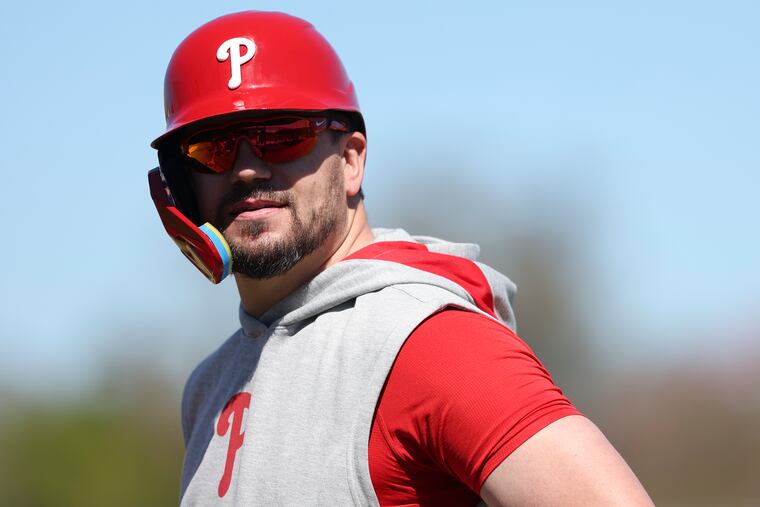Kyle Schwarber had a ‘weird’ 2023 season. Here’s what the Phillies slugger wants to change.
How weird? Schwarber banged 47 homers, scored 108 runs, knocked in 104, drew 126 walks, and struck out 215 times. And hit .197.

CLEARWATER, Fla. — If you watched the Phillies last season and couldn’t recall another hitter — leadoff, or otherwise — who put up the numbers that Kyle Schwarber did, well, it’s because you probably hadn’t.
“It was definitely weird,” Schwarber said Friday.
How weird? Schwarber banged 47 homers, scored 108 runs, knocked in 104, drew 126 walks, and struck out 215 times. In baseball history, there has been only one other 40-100-100-100-200 player: Aaron Judge — and he batted .284 for the Yankees as a rookie in 2017.
Schwarber hit .197 for the 2023 Phillies.
» READ MORE: How do the Phillies chase a World Series title, and long-term winning? Follow the money.
“We would always joke about it in the clubhouse, in the [batting] cage,” Schwarber said. “Guys were like, ‘What the heck’s going on?’ If you’d have told me I was going to hit .190-whatever and hit 47 bombs and drive in 100, score 100, and punch out 200 times, I would’ve said you’re crazy.
“But it happened, right? I lived it.”
And when he returned home to Ohio after the Phillies’ Game 7 loss in the NL Championship Series, he went about figuring out how to never, ever live it again.
It wasn’t that Schwarber had a bad season. Based on OPS+, a metric that contextualizes a hitter’s output by accounting for factors such as ballpark effects, he actually was 22% better than league average, on par with the rest of his nine-year major-league career.
But two numbers stood out when Schwarber reflected on his year:
A 52.5% pull rate.
433 two-strike counts in 720 plate appearances.
In both cases, Schwarber led the league. In both cases, he sees room for improvement.
» READ MORE: The Phillies are making big strides on defense, and it could make a big difference
Schwarber has never been an extreme pull hitter. When he participated in the home run derby at the 2022 All-Star Game, he allayed concerns that the contest would mess with his swing because his left-handed power always translated to left-center field as much as it did to right.
How come, then, he got so pull-happy last season?
Schwarber dealt with a balky knee that hampered him on the bases and in the outfield. Maybe that had something to do with it. Or maybe the new rules got in his head. Everyone thought his batting average would rise with the elimination of defensive shifts. Did he knowingly, or even subconsciously try to pull more balls through the right side?
“I just think I just got into some bad habits,” said Schwarber, whose career pull rate in 43.7%. “There was some mechanical stuff that needed to get cleaned up. In the season, you’re trying to make changes. But at the end of the day, you can’t be thinking, ‘Try to go opposite field.’ I’m just trying to go out there and hit the ball and make good contact, you know?”
Schwarber explained that he over-rotated and was “spinning out to hit the ball to where you’re not really having the direction that I want to have.” Rather than going to left field on, say, fastballs away, he was trying to yank them to right.
This spring, as he transitions to primarily a designated-hitter role with Bryce Harper making the full-time move to first base and Brandon Marsh and Johan Rojas likely occupying left and center field, Schwarber is focusing on hitting the ball where it’s pitched. Generally speaking, that means pulling inside pitches and going the other way on pitches away.
» READ MORE: Phillies’ trust in Cristopher Sánchez endures even with star pitchers still on the market
But what if using more of the field enables him to make more contact but at the expense of some power? In 2021, with the Nationals and Red Sox, he pulled the ball 43.8% of the time and batted .266 but hit 32 homers.
“I don’t know,” Schwarber said. “Don’t get me wrong: I’m going to pull the baseball. It’s not me going up there saying, ‘Hit the ball to the opposite field.’ It’s just a club in the bag. Not just trying to do damage to only one side of the field. It’s trying to open up the whole field.”
The two-strike issue is trickier. Schwarber is known for his selectivity at the plate. He sees more pitches than almost any hitter in baseball, works deep counts, and draws a lot of walks, qualities that made him manager Rob Thomson’s preferred choice to lead off the last two seasons, even though he’s the antithesis of a prototypical leadoff man.
But Schwarber also believes he can benefit from being more aggressive.
“If I’m over 70% [of the time] in two-strike counts, I’m just putting the odds against me,” he said. “So I might not want to walk 120 [times]. I might not want to do that. I might want to be a little more swinging and getting going earlier [in the count].”
Schwarber isn’t going to morph into a .300 hitter, and he may still lead the league in strikeouts, as he did the last two seasons. But after hitting almost as many homers as singles (47 to 48) last season, he doesn’t want to remain the epitome of a three-true-outcome hitter who racks up homers, walks, strikeouts, and little else.
“People think that I’m trying to go up there and just hit homers. That’s not the case,” Schwarber said. “That’s the last thing I’m doing. You just run in [homers], you know?
“I just know that there’s more [of a] hitter in there.”
» READ MORE: Owner John Middleton on Phillies’ huge offer to Yoshinobu Yamamoto, saving the ‘powder’ for July, and more